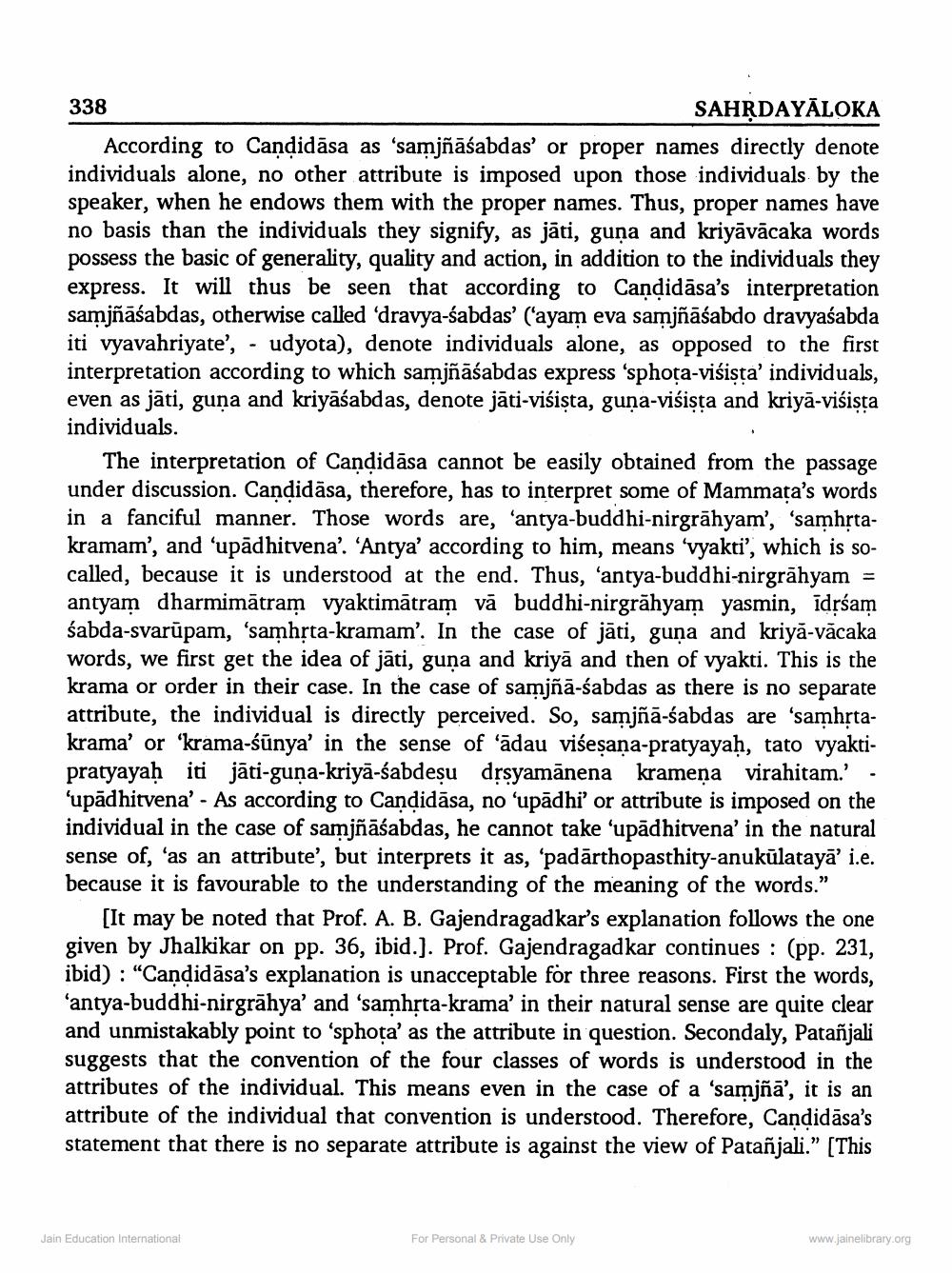________________
338
SAHRDAYALOKA
According to Candidāsa as 'samjñāśabdas' or proper names directly denote individuals alone, no other attribute is imposed upon those individuals by the speaker, when he endows them with the proper names. Thus, proper names have no basis than the individuals they signify, as jāti, guna and kriyāvācaka words possess the basic of generality, quality and action, in addition to the individuals they express. It will thus be seen that according to Candidāsa's interpretation samjñāśabdas, otherwise called 'dravya-śabdas' ('ayam eva samjñāśabdo dravyaśabda iti vyavahriyate', - udyota), denote individuals alone, as opposed to the first interpretation according to which samjñāśabdas express 'sphoța-visista' individuals, even as jāti, guna and kriyāśabdas, denote jāti-visista, guna-visista and kriyā-visista individuals.
The interpretation of Candidāsa cannot be easily obtained from the passage under discussion. Candidāsa, therefore, has to interpret some of Mammata's words in a fanciful manner. Those words are, antya-buddhi-nirgrāhyam', 'samhstakramam', and 'upādhitvena'. 'Antya' according to him, means 'vyakti', which is socalled, because it is understood at the end. Thus, 'antya-buddhi-nirgrāhyam = antyam dharmimātram vyaktimātram vā buddhi-nirgrāhyam yasmin, idrśam śabda-svarūpam, 'samhrta-kramam'. In the case of jāti, guna and kriya-vācaka words, we first get the idea of jāti, guna and kriya and then of vyakti. This is the krama or order in their case. In the case of samjñā-sabdas as there is no separate attribute, the individual is directly perceived. So, samjñā-śabdas are 'samhịtakrama' or 'krama-śünya' in the sense of tādau visesana-pratyayah, tato vyaktipratyayah iti jāti-guna-kriyā-śabdesu drsyamānena kramena virahitam.'. ‘upādhitvena' - As according to Candidāsa, no 'upādhi' or attribute is imposed on the individual in the case of samjñāśabdas, he cannot take 'upādhitvena' in the natural sense of, 'as an attribute', but interprets it as, 'padārthopasthity-anukūlatayā' i.e. because it is favourable to the understanding of the meaning of the words."
[It may be noted that Prof. A. B. Gajendragadkar's explanation follows the one given by Jhalkikar on pp. 36, ibid.). Prof. Gajendragadkar continues : (pp. 231, ibid) : "Candidāsa's explanation is unacceptable for three reasons. First the words, antya-buddhi-nirgrāhya' and 'samhrta-krama' in their natural sense are quite clear and unmistakably point to 'sphoța' as the attribute in question. Secondaly, Patañjali suggests that the convention of the four classes of words is understood in the attributes of the individual. This means even in the case of a 'samjñā', it is an attribute of the individual that convention is understood. Therefore, Candidāsa's statement that there is no separate attribute is against the view of Patañjali.” [This
Jain Education International
For Personal & Private Use Only
www.jainelibrary.org




